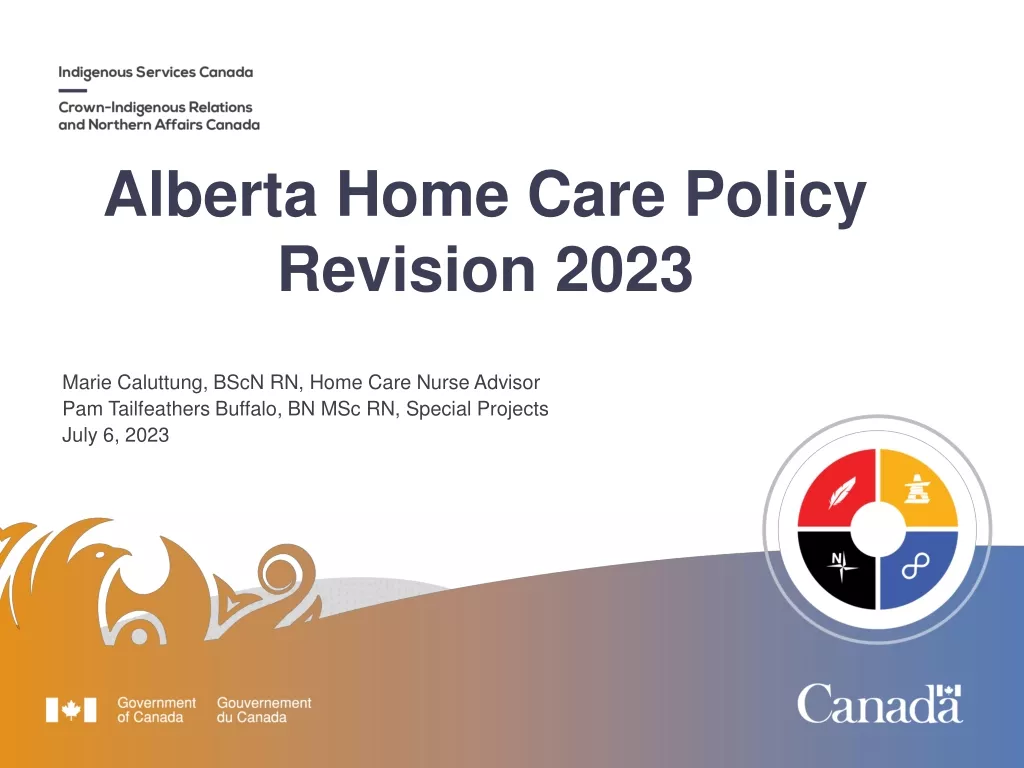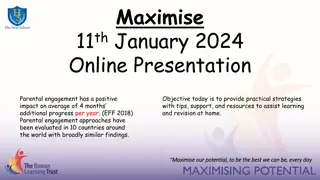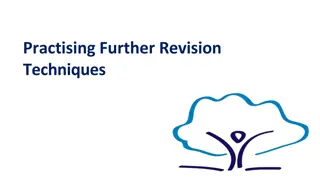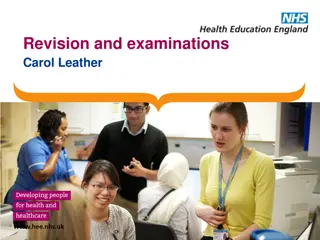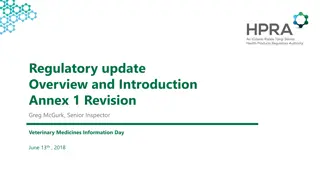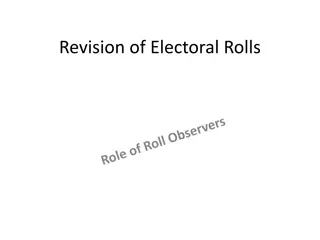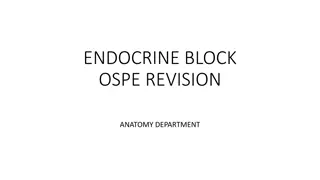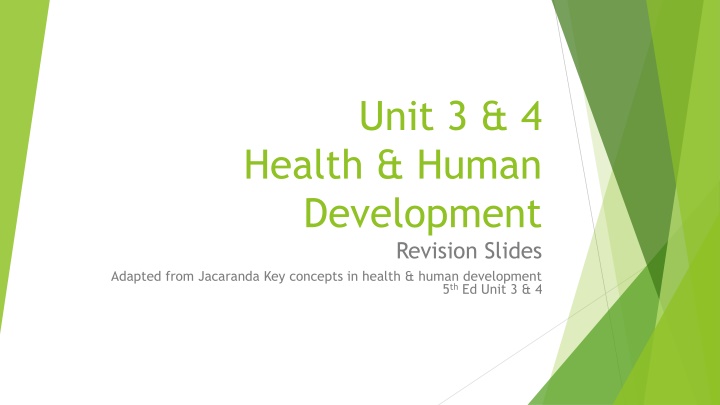
Health and Wellbeing: Key Concepts and Benefits
Explore the dynamic and subjective nature of health and wellbeing, including the interrelationships between different dimensions. Discover the importance of optimal health for individuals, communities, and the global society, as well as the benefits it brings. Learn about the prerequisites for health as identified by the WHO.
Download Presentation

Please find below an Image/Link to download the presentation.
The content on the website is provided AS IS for your information and personal use only. It may not be sold, licensed, or shared on other websites without obtaining consent from the author. If you encounter any issues during the download, it is possible that the publisher has removed the file from their server.
You are allowed to download the files provided on this website for personal or commercial use, subject to the condition that they are used lawfully. All files are the property of their respective owners.
The content on the website is provided AS IS for your information and personal use only. It may not be sold, licensed, or shared on other websites without obtaining consent from the author.
E N D
Presentation Transcript
Unit 3 & 4 Health & Human Development Revision Slides Adapted from Jacaranda Key concepts in health & human development 5thEd Unit 3 & 4
Unit 3-AOS 1- Understanding health & wellbeing Concepts of health and wellbeing (including physical, social, emotional, mental and spiritual dimensions) and illness, and the dynamic and subjective nature of these concepts Optimal Health & well being is when the dimensions of health (Spiritual, Physical, Emotional, Mental and Social) are working together and creates a state where the individual feels happy, healthy, capable and engaged. Good health & well being is subjective- it means different things to different people It is also dynamic- it can change very quickly, impacting on another dimension. It is essential that you can explain and give examples of each dimension of health & well being (SPEMS) Can you explain how these dimensions interrelate?
Unit 3-AOS 1- Understanding health & wellbeing Test yourself key skills o explain the dynamic and subjective nature of the concepts of health and wellbeing and illness o describe interrelationships between dimensions of health and wellbeing
Unit 3-AOS 1- Understanding health & wellbeing Benefits of optimal health and wellbeing and its importance as a resource individually, nationally and globally Good health and well being is essential for human existence- it reduces the risk of injury, illness and premature death It enables individuals to live healthy, productive lives. Work, sleep, exercise, earn an income and care for themselves and their family If a population is experiencing good levels of health & well being, the economy will benefit- this is generally measured through pressure on the health system, employment levels, productivity Optimal health & well being will also lead to global benefits such as less risk of communicable diseases, peace & stability, sustainability and, social & economic development
Unit 3-AOS 1- Understanding health & wellbeing Test yourself key skills explain the individual and collective importance of health and wellbeing as a resource describe global benefits of the pursuit of optimal health and wellbeing
Unit 3-AOS 1- Understanding health & wellbeing Prerequisites for health as determined by the WHO including peace, shelter, education, food, income, a stable eco-system, sustainable resources, social justice and equity These prerequisites can impact health & well being in countless ways People Should Eat Food Including Some Sustainable Salad Everyday You must understand what each one entails: Peace- absence of conflict Shelter- a structure that provides protection from the outside environment Education- empowers individuals & increases their chances of having a purposeful life Food- adequate food is essential for life Income- an underlying factor for several health & wellbeing outcomes Stable eco-system- balance between the environment and the species that live in that environment Sustainable resources- ensuring resources are available for future generations Social justice/equity- equal rights for all, fairness
Unit 3-AOS 1- Understanding health & wellbeing Test yourself key skills identify the WHO s prerequisites for health and explain their links to improved health outcomes People should eat food, including some sustainable salad, enjoyably (PSEFISSSE)
Unit 3-AOS 1- Understanding health & wellbeing Indicators used to measure and understand health status: incidence, prevalence, morbidity, burden of disease, disability-adjusted life year (DALY), life expectancy, health-adjusted life expectancy (HALE), mortality (including maternal, infant and under 5) and self-assessed health status You need to have an understanding of each one of these indicators You also need to understand the concept of self-assessed health status- a person s perception of their own health & well being at any given time These factors will generally be teamed with data analysis type questions You need to specifically analyse patterns in morbidity (ill health) & mortality (death at a population level) in Australia
Unit 3-AOS 1- Understanding health & wellbeing Test yourself key skills describe and apply indicators used to measure health status use data to describe and evaluate the health status of Australians analyse patterns in morbidity and mortality in Australia over time Exam Tip When a questions refers to effects on health status you may only refer to: Morbidity, Mortality, Life Expectancy, Maternal Mortality, infant mortality, U5MR, Self-assessed health status, prevalence, incidence When a question asks for effects on BOD you may only refer to: YLL YLD DALY
Unit 3-AOS 1- Understanding health & wellbeing Health status of Australians and the biological, sociocultural and environmental factors that contribute to variations between population groups including: males and females Indigenous and non-Indigenous high and low socioeconomic status those living within and outside of Australia s major cities You MUST have an understanding of each of these population groups and how their health differs. For example: Main differences in health status in these groups What ways the factors contribute to variations in health status
Unit 3-AOS 1- Understanding health & wellbeing You MUST have an understanding about what each of the factors entail: Biological (BBGBBG)- genetics, body weight, blood pressure, blood cholesterol, birth weight, glucose regulation Sociocultural (FUSSACHE)- socio economic status, unemployment, social connections, social exclusion, social isolation, cultural influences, food security, early life experiences, access to healthcare Environmental (CHUW)- housing, work environment, urban design & infrastructure, climate and climate change Exam Tip - Data will most likely be used to assess this knowledge, usually a graph followed by an analysis of which factors cause the trend seen Exam tip when a question lists 2 population groups you must include a reference to BOTH groups in your answer.
Unit 3-AOS 1- Understanding health & wellbeing Test yourself key skills analyse health information to explain factors that contribute to variations in health status between population groups
Unit 3-AOS 1- Understanding health & wellbeing The contribution to Australia s health status and burden of disease of smoking, alcohol, high body mass index, and dietary risks (under-consumption of vegetables, fruit and dairy foods; high intake of fat, salt and sugar; low intake of fibre and iron) Australian s generally have very good health status and it continually improves as the years go on. There are 4 factors that contribute 25% of the burden of disease You need to be familiar with each one: Smoking- what does it do to our bodies Alcohol- alcohol misuse, what conditions does it lead to? High body mass index- how to measure and classification, what does that lead to? Dietary risks- under consumption of fruit, vegetables and dairy foods, high intake of fat, salt & sugar, low intake of fibre and iron how does the consumption lead to disease?
Unit 3-AOS 1- Understanding health & wellbeing Test yourself key skills use data to describe and evaluate the health status of Australians
Unit 3- AOS 2- Promoting health & well being improvements in Australia s health status since 1900 and reasons for these improvements, focusing on policy and practice relating to: old public health the biomedical approach to health and improvements in medical technology development of new public health including the social model of health and Ottawa Charter for Health Promotion the relationship between biomedical and social models of health You need to have an understanding about what each one of the concepts above refer to- including the strengths & limitations for each, how they have contributed to improvements in specific health and well being concerns You also need to have a general understanding about how Australia s health status has changed over time Life expectancy- significant improvements have been made Mortality- changes in the diseases that kill us (from communicable to non-communicable) How have the old public health, biomedical approach and new public health contributed to these changes?
Unit 3- AOS 2- Promoting health & well being Let s break down the policies and practice behind each factor: Old public health- focus on physical environment (water, sewerage systems, sanitation, housing), discovering vaccines to prevent diseases, starting to focus on health promotion rather than just cure Biomedical approach- has increased life expectancy, reduced death rates and improved infant mortality, can be referred to as Band-Aid or quick fix approach, focuses on the physical or biological aspects of disease or illness, diagnosing and treating illnesses, uses technology New public health (social model of health/Ottawa Charter)- brought about an understanding of the significant influence of physical, socio cultural and political environments Social model- has five key principles -IDEAR (acts to reduce social inequities, involves intersectoral collaboration, addresses the broader determinants of health, empowers individuals & communities, acts to enable access to healthcare) Ottawa Charter- (Bad Cats Smell Dead Rats) this is a framework that was a response to the ideas behind the social model of health approach, includes three strategies (advocate, enable, mediate) and five action areas (build healthy public policy, create supportive environments, strengthen community action, develop personal skills, re-orient health services)
Unit 3- AOS 2- Promoting health & well being Test yourself key skills analyse data that show improvements in health over time and draw conclusions about reasons for improvements analyse the strengths and limitations of biomedical and social models of health in bringing about improvements in health status
Unit 3- AOS 2- Promoting health & well being Australia s health system, including Medicare, private health insurance, the Pharmaceutical Benefits Scheme and the National Disability Insurance Scheme, and its role in promoting health in relation to funding, sustainability, access and equity You need to have an understanding of each of the elements above: Medicare- Australia s universal health insurance scheme, available to all Australian s, permanent residents, what s covered? what s not covered? how is it funded? what is the safety net? PBS- provide essential medicines to those that require them at a subsidised price NDIS- national insurance scheme that provides services and support for people with permanent, significant disabilities PHI- insurance where members pay a premium for health related costs not covered by Medicare, What services does it cover? Incentives for taking up this cover - Rebate, life time health cover, Medicare levy surcharge
Unit 3- AOS 2- Promoting health & well being How does the following apply to each system? Funding- how is it funded to keep the health system adequately staffed and resourced? Sustainability- What measures are taken to ensure that this system can continue into the future, and often how does this reduce the burden on the public system? Access What features of this system ensure that all people have access to it s services? Equity- How does it ensure that disadvantaged groups are provided with equal access to the system? Does it have a safety net?
Unit 3- AOS 2- Promoting health & well being Test yourself key skills analyse the role of Medicare, private health insurance, the Pharmaceutical Benefits Scheme and the National Disability Insurance Scheme in promoting Australia s health
Unit 3- AOS 2- Promoting health & well being The role of health promotion in improving population health, focusing on smoking, including: why it was/is targeted effectiveness of the health promotion in improving population health how the health promotion reflects the action areas of the Ottawa Charter for Health Promotion Initiatives introduced to bring about improvements in Indigenous health and wellbeing in Australia and how they reflect the action areas of the Ottawa Charter for Health Promotion
Unit 3- AOS 2- Promoting health & well being In all these KK points you really need to understand how to apply the five action areas of the Ottawa Charter. You MUST have thorough knowledge of the action areas which you have already been introduced to It is more than just knowing the name of each area, you have to understand what each action area relates to! Use your knowledge of the Ottawa Charter to judge how effective initiatives have been to improving health & well being; It would be a good idea to have knowledge of one of the programs discussed in your textbook that are specific to Indigenous Australians learn, earn legend 2spirits, be deadly get healthy etc. Initiatives designed to target smoking - National Tobacco Framework, QUIT, Quit for you quit for 2
Unit 3- AOS 2- Promoting health & well being Initiatives to promote healthy eating in Australia including Australian Dietary Guidelines and the work of Nutrition Australia, and the challenges in bringing about dietary change. You need to have adequate knowledge of the following: The Australian dietary guidelines (naming all 5) and the Australian Guide to Healthy Eating (what guidelines is it based upon?) Work of Nutrition Australia- The healthy eating pyramid, the healthy eating advisory service, national nutrition week, developing educational resources, nutrition seminars and workshops, webinars for health professionals, publication of recipes There are also challenges in bringing about dietary change. The following are the primary challenges that you should be familiar with- personal preference, attitudes & beliefs, will power, food security, time constraints & convenience, education, nutrition knowledge & cooking skills, family, culture, society & religion, food marketing & media, and health & well being factors
Unit 3- AOS 2- Promoting health & well being Test yourself key skills apply the action areas of the Ottawa Charter for Health Promotion to a range of data and case studies evaluate initiatives in terms of their capacity to improve Indigenous health and wellbeing draw conclusions as to why dietary improvements are difficult to achieve in Australia
Unit 4-AOS 1- Health & well being in a global context Characteristics of high-, middle- and low-income countries Similarities and differences in health status and burden of disease in low- , middle- and high-income countries, including Australia Factors that contribute to similarities and differences in health status and burden of disease, including access to safe water; sanitation; poverty; inequality and discrimination (race, religion, sex, sexual orientation and gender identity); and global distribution and marketing of tobacco, alcohol and processed foods This is often asked in conjunction with data analysis interpret the data then be asked what factors lead to the differences seen between countries
Unit 4-AOS 1- Health & well being in a global context You should have an idea of how GNI (gross national income) plays a part in the differences between countries You also need to understand the characteristics of each group- high, middle, low & how they affect health status & burden of disease There can be variations between countries, however as a general rule of thumb the following applies to most: Economic- lower levels of poverty, wide range of industries, opportunities for global trade, high average incomes Social- higher levels of gender equality, low birth rates & population growth, high levels of employment, high levels of education, developed social security systems, developed health systems, access to technology, developed legal systems, no history of colonisation Environmental- access to safe water & sanitation, food security, adequate housing, adequate infrastructure, high levels of carbon dioxide emissions
Unit 4-AOS 1- Health & well being in a global context In order to identify similarities and differences key indicators are used via data Life expectancy, mortality, morbidity, burden of disease You should already be somewhat familiar with these indicators There are also factors which will contribute to these differences Access to safe water Sanitation Poverty Inequality & discrimination Global distribution and marketing of tobacco, alcohol and processed foods
Unit 4-AOS 1- Health & well being in a global context Test yourself key skills describe characteristics of high-, middle- and low-income countries evaluate data to analyse similarities and differences between countries in relation to health status and burden of disease analyse factors that contribute to health status and burden of disease in different countries and discuss their impact on health and wellbeing compare health data and other information to analyse reasons for health inequalities within and between nations
Unit 4-AOS 1- Health & well being in a global context The concept and dimensions of sustainability (environmental, social, economic) and its role in the promotion of health and wellbeing Ensuring sustainability in all policies, procedures and developments in the promotion of health is very important You need to have knowledge about the concept of sustainability and the three dimensions: Concept- meeting the needs of the present without compromising the ability of future generations to meet their own needs Social- creating an equitable society that meets the needs of all citizens and can be maintained indefinitely (elimination of poverty and the provision of social protection systems, gender equality, access to safe and decent working conditions, promotion of political and legal rights, peace & security) Environmental- biodiversity, use of natural resources, waste removal and pollution, climate change) Economic- the capacity of future generations to earn an income, the efficient use of resources (innovation & diversity of industries, employment, economic growth, trade)
Unit 4-AOS 1- Health & well being in a global context Test yourself key skills explain sustainability (environmental, social, economic) and its importance in the promotion of health and wellbeing in a global context
Unit 4-AOS 1- Health & well being in a global context The concept of human development, including advantages and limitations of the Human Development Index You need to have an understanding of the definition of human development- you will not have to remember it word for word , however you should attempt to remember key phrases within the definition: Creating an environment in which people can develop to their full potential and lead productive, creative lives according to their needs and interests. It is about expanding people s choices and enhancing capabilities, having access to knowledge, health and a decent standard of living, and participating in the life of their community and decisions affecting their lives
Unit 4-AOS 1- Health & well being in a global context You also need to understand the Human Development Index (HDI) and how it can impact on human development The HDI is considered a tool to help measure levels of human development (which is very difficult) It was developed by the United Nations It aims/attempts to measure and rank countries levels of social and economic development It provides a single statistic based on three dimensions (a long healthy life, knowledge and a decent standard of living) and four indicators (life expectancy at birth, mean years of schooling, expected years of schooling, gross national income per capita) Understand what the numbers refer to? What are the advantages and disadvantages of the HDI?
Unit 4-AOS 1- Health & well being in a global context Test yourself key skills explain the Human Development Index and evaluate its usefulness in measuring human development of countries Exam Tip these questions often ask you to link your knowledge from what factors are used to calculate the HDI to what the potential impacts are on the human development experienced.
Unit 4-AOS 1- Health & well being in a global context Implications for health and wellbeing of global trends including: climate change (rising sea levels, changing weather patterns and more extreme weather events) conflict and mass migration increased world trade and tourism digital technologies that enable increased knowledge sharing The focus of this KK is the concept of globalisation (boundaries between countries are reduced or eliminated allowing individuals/companies to act on a global scale) AND global trends (social, environmental & economic activity) AND how they impact on health & well being on a global scale You will need to have an understanding of each of these implications and they relate back to health & well being
Unit 4-AOS 1- Health & well being in a global context Test yourself key skills analyse the implications for health and wellbeing of particular global trends
Unit 4-AOS 2- Health & the SDGs Rationale and objectives of the UN s SDGs Key features of SDG 3 Ensure healthy lives and promote wellbeing for all at all ages Relationships between SDG 3 and SDGs 1, 2, 4, 5, 6 and 13 that illustrate collaboration between the health sector and other sectors in working towards health-related goals This when you will learn about the sustainable development goals (SDGs) for the first time For the remainder of the AOS, they will be regularly referred to You need to understand why the United Nations developed the SDGs, what they are, when they were developed, why they were developed, the period they are relevant for and their objectives You need to list them by name and number, not one or the other You MUST know about the features of SDG 3 in detailed wording close enough is NOT good enough in this dot point You MUST then be able to relate SDG 3 to SDGs 1, 2, 4, 5, 6, & 13, going both ways
Unit 4-AOS 2- Health & the SDGs Let s delve in to what the SDGs are all about: There are 17 goals. They were introduced in 2016 They are set to be achieved by 2030 They were developed via a collaboration between the United Nations, non- government organisations & people around the world with a view to make the world a better place The SDGs tackle global challenges and aim to meet the needs of ALL people in ALL countries They have 5 areas of importance- people, planet, partnership, peace, prosperity Rationale- The Millennium Development Goals (MDGs) finished in 2015. A new set of goals and targets were needed, leading to the SDGs. Progress was uneven across regions and countries and there were also new global challenges that needed to be acknowledged (climate change and global conflict) Objectives- the 17 goals work together to achieve three major objectives- end extreme poverty, fight inequality & injustice, address climate change
Unit 4-AOS 2- Health & the SDGs The goals are interconnected- they are all equally important You need to know about SDG 3- Good health & well being in detail You also need to know the following SDGs in depth AND how they relate back to SDG 3: SDG 1- No poverty SDG 2- Zero hunger SDG 4- Quality education SDG 5- Gender equality SDG 6- Clean water & sanitation SDG 13- Climate action
Unit 4-AOS 2- Health & the SDGs SDG 3- Ensure healthy lives and promote well being for all at all ages Aims to achieve health & well being for everyone, at every stage of life Providing universal health coverage is a key target for the SDG Key features you should be familiar with are: Reduce maternal mortality End preventable newborn and child deaths and reduce neonatal mortality End the epidemics of communicable diseases (AIDS / Tuberculosis/ Malaria/ Neglected Tropical Diseases, Hepatitis, Water Borne Diseases, ) reduce premature mortality from non-communicable diseases and promote mental health and wellbeing ensure universal access to sexual and reproductive healthcare service increase investment in healthcare services and qualified healthcare staff, especially in low-income countries and small island developing states support the research and development of vaccines and medicines for communicable and non- communicable diseases and provide access to affordable essential medicines and vaccines All other SDGs- 1, 2, 4, 5, 6 & 13 need to be reviewed
Unit 4-AOS 2- Health & the SDGs Test yourself key skills describe the objectives of the UN s SDGs and justify their importance describe key features of SDG 3 and analyse its relationships with other SDGs in collaborative approaches to improving health and wellbeing, and human development globally DON T FORGET! You will need to be able to refer back to health & well being You will also need to refer back to Human Development
Unit 4-AOS 2- Health & the SDGs Priorities and work of the WHO The strategic direction is based on the Sustainable Development Goals (SDGs) with a commitment to achieve Goal 3 (Ensure healthy lives and promote well- being for all at all ages) WHO mission is to promote health; Keep the world safe; and serve the vulnerable The priorities of the WHO are: Universal health coverage 1 billion more people benefitting from universal health coverage Health emergencies 1 billion more people better protected from health emergencies Healthier populations 1 billion more people enjoying better health and well-being
Unit 4-AOS 2- Health & the SDGs Test yourself key skills explain the priorities and the work of the WHO and discuss how the WHO priorities are reflected in different scenarios


